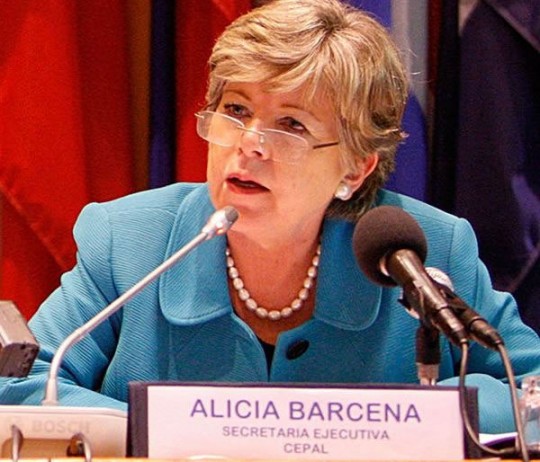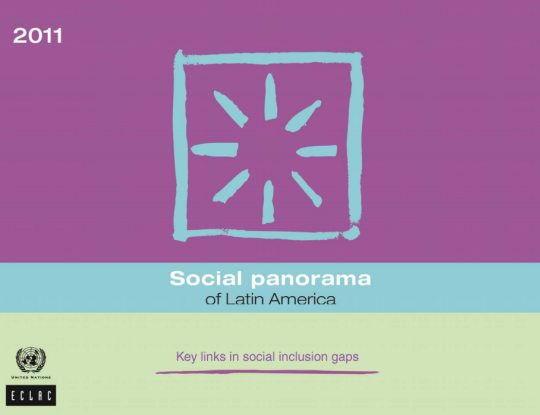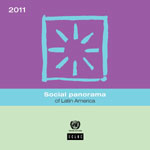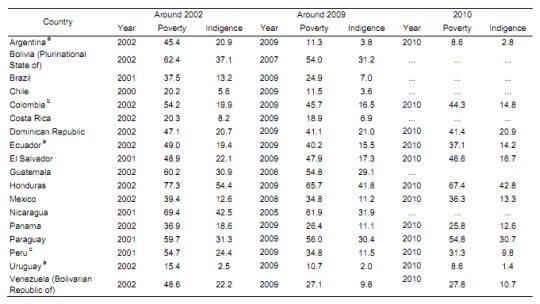Latin American poverty levels fall to lowest in two decades, UN report finds
Latin American poverty levels fall to lowest in two decades, UN report finds
30 November 2011 – Poverty rates in Latin America have dropped to their lowest levels in 20 years, according to a new United Nations report which highlights public spending levels as one of the key factors that has allowed the continent to continue to grow despite the global economic crisis.
Between 1990 and 2010, the poverty rate decreased from 48.4 per cent to 31.4 per cent, while the rate of indigence – or extreme poverty – fell from 22.6 per cent to 12.3 per cent.
The decline in both rates is mainly due to an increase in wages, according to the latest report by the Economic Commission for Latin America and the Caribbean (ECLAC). Public money transfers were also a contributing factor, but to a much lesser extent.
The report, presented yesterday in Santiago, Chile, predicts that the region will close this year with 174 million people living in poverty compared to 177 million in 2010.
“Poverty and inequality continue to decline in the region, which is good news, particularly in the midst of an international economic crisis,” said ECLAC’s Executive Secretary Alicia Bárcena.
The report also forecasts that the poverty rate will continue to drop in the next year. However, it states that the indigence rate may have slightly increased (up to 12.8 per cent) because of the rise in food prices.
The report reveals that public spending, and in particular social expenditure, received a significant boost in most countries over the past 20 years.
“In response to the global economic crisis, the countries opted to temporarily expand public spending rather than to shrink it, which was the action traditionally taken. Although, the emphasis is not always placed on society, expansion still prevented the rise in unemployment and social vulnerability,” the report reads.
The report spotlights countries that had substantial drops in poverty in the past year, including Peru, Ecuador, Argentina, Uruguay and Colombia.
However, Ms. Bárcena warned that progress is threatened by gaps in the productive structure of the region and by labour markets without social protection. Only four out of every 10 workers with formal work are enrolled in the social security system, with a large majority of older persons, women, and workers in rural areas being left out of its benefits.
“To jointly improve productive convergence, labour institutionality and universal social protection in Latin America, steps towards fiscal pacts and social dialogue must be taken,” said Ms. Bárcena.
The report also discusses fertility in the continent, observing that over the past 50 years, the fertility rate dropped rapidly, compared with a moderate drop in adolescent fertility. In addition, a chapter on the Caribbean has been included for the first time, which warns of the high level of unemployment and incidence of HIV/AIDS among young people.
###
According to ECLAC publication presented today:
29 November 2011 – Today, the Economic Commission for Latin America and the Caribbean (ECLAC) reported that between 1990 and 2010 the poverty rate in Latin America dropped by 17 percentage points (from 48,4% to 31,4%) , while the indigence rate fell by 10.3 percentage points (from 22,6% to 12,3%). Therefore, both indicators are at their lowest levels in 20 years.
The publication Social Panorama of Latin America 2011 presented in Santiago, Chile, by the Executive Secretary of ECLAC, Alicia Bárcena, states that the poverty level will drop to 30.4% in 2011, while the indigence rate will increase slightly to 12.8% because the rise in food prices would counteract the predicted rise in household incomes.
This means that the region will close this year with 174 million inhabitants living in poverty, 73 million of which are living in extreme poverty or indigence. In 2010, there were 177 million poor, 70 million of which were living in indigence.
According to ECLAC, the decrease in poverty is primarily due to an increase in labour income. Public monetary transfers also contributed, but to a lesser extent.
“Poverty and inequality continue to decline in the region, which is good news, particularly in the midst of an international economic crisis. However, this progress is threatened by the yawning gaps in the productive structure in the region and by the labour markets which generate employment in low-productivity sectors, without social protection,” warned Alicia Bárcena.
Between 2009 and 2010, significant drops in poverty rates were observed in five countries: Peru, Ecuador, Argentina, Uruguay and Colombia.
Honduras and Mexico were the only countries with significant rises in their poverty rates (1.7% and 1.5% respectively). As for Mexico, the comparison was made with the poverty rate for 2008; therefore, the figure does not only reflect the economic growth in Mexico in 2010, but also the major GDP per capita contractions in 2009.
The publication also highlights that the improvement in distribution was not affected following the economic crisis. Between 2008-2010 in Mexico, Venezuela and Uruguay, the Gini index dropped to an annual rate of over 2% and in El Salvador and Peru it was over 1% per year.
Furthermore, the Social Panorama of Latin America 2011 reveals that public expenditure, and in particular social expenditure, has increased significantly over the past 20 years in the region.
The lowest spending per capita (less than US$ 300) is in Bolivia, Ecuador, Guatemala, Honduras, Nicaragua and Paraguay. These countries spend the most on education. However, in the countries which have social spending per capita of over US$ 1,000, such as Argentina, Brazil, Chile, Costa Rica, Cuba, Trinidad and Tobago and Uruguay, the most spending is on social security and assistance.
In response to the global economic crisis, the countries opted to temporarily expand public spending rather than to shrink it, which was the action traditionally taken. Although, the emphasis is not always placed on society, expansion still prevented the rise in unemployment and social vulnerability.
The ECLAC study also analyses in depth the existing gaps in the world of work and social protection in Latin America.
Not all employees in formal work are enrolled in the social security system: only 4 out of every 10 workers make contributions.
Households with larger numbers of family members, female heads of house and located in rural sectors are those which have less access to contributory protection in the region. Likewise, in 12 out of 17 countries analysed, the social security and pension contributions benefit less than half of older persons.
According to ECLAC, in the medium and long term many countries should reform their social security schemes again to take steps towards rights-based social protection systems, based on contributory and non-contributory finance mechanisms supporting the distribution of resources.
Otherwise, there will continually be problems relating to financing universal social protection in ageing societies with a smaller workforce.
“To jointly improve productive convergence, labour institutionality and universal social protection in Latin America, steps towards fiscal pacts and social dialogue must be taken,” stated Ms. Bárcena.
The ECLAC publication also discusses the situation of fertility in Latin America. Over the past 50 years, the global fertility rate observed dropped rapidly, compared with the moderate drop in adolescent fertility. In addition, a chapter on the Caribbean has been included for the first time, which warns of the high level of unemployment and the incidence of HIV/AIDS among young people in the subregion.
###
SUMMARY
For Social Panorama of Latin America, the main challenge is to foster a more in-depth examination of social gaps and the mechanisms that reproduce or decrease them. The previous edition of Social Panorama homed in on inequality gaps and their intergenerational reproduction and paid particular attention to the formative years of individuals, their transition to adult life and the role of social expenditure and transfers in meeting the needs of new generations during their early years. It showed how the life cycle path is determined by differences in skill development and how inequality and poverty become entrenched as people move from one stage of life to the next.
The 2011 edition of Social Panorama of Latin America takes a more in-depth look at the chain that produces and reproduces social gaps; it addresses other spheres as well. It focuses on how structural heterogeneity (productivity gaps in the national economies), labour segmentation and gaps in social protection are linked along the chain. Demographic factors such as fertility differentiated by education and income level are discussed, as are more specific patterns of risk and exclusion like those impacting young people in the Caribbean.These gaps make for an ambivalent scenario in the region, combining structural tendencies that reinforce them with recent, favourable developments that open new possibilities for advancing towards less unequal societies with broader access to well-being. Poverty and inequality are decreasing in the region; the main reasons are, first, rising labour income and, second, increasing public transfers to the most vulnerable sectors. But the productive gaps are still rigid, and there is still little mobility for specific groups in low-productivity sectors (especially women in lower-income socioeconomic groups) whose income has not increased. Fertility is declining substantially and can mean greater possibilities for well-being among families with fewer dependents.
###
LATIN AMERICA: POVERTY AND INDIGENCE, 1980-2011a
(Percentages and millions of persons)
Source: Economic Commission for Latin America and the Caribbean (ECLAC), on the basis of special tabulations of
data from household surveys conducted in the respective countries.
a /Estimate for 18 countries of the region plus Haiti. The figures above the bars represent the percentage and total
number of poor persons (indigent plus non-indigent poor), respectively. The figures for 2011 are projections.
###
LATIN AMERICA (18 COUNTRIES): PERSONS LIVING IN POVERTY AND INDIGENCE,
AROUND 2002, 2009 AND 2010
(Percentages)
Source: Economic Commission for Latin America and the Caribbean (ECLAC), on the basis of special tabulations of data from household surveys conducted in the relevant countries.
a. Urban areas.
b. Figures from the Misión para el empalme de las series de empleo, pobreza y desigualdad (MESEP). These figures do not include the changes in the measurement of poverty made in 2011 by the National Planning Department (DNP) of Colombia.
c. Figures from the National Institute of Statistics and Information (INEI) of Peru.
###
> About Economic Commission for Latin America (ECLAC)
 The Economic Commission for Latin America (ECLA) – the Spanish acronym is CEPAL- was established by Economic and Social Council resolution 106(VI) of 25 February 1948 and began to function that same year. The scope of the Commission’s work was later broadened to include the countries of the Caribbean, and by resolution 1984/67 of 27 July 1984, the Economic Council decided to change its name to the Economic Commission for Latin America and the Caribbean (ECLAC); the Spanish acronym, CEPAL, remains unchanged.
The Economic Commission for Latin America (ECLA) – the Spanish acronym is CEPAL- was established by Economic and Social Council resolution 106(VI) of 25 February 1948 and began to function that same year. The scope of the Commission’s work was later broadened to include the countries of the Caribbean, and by resolution 1984/67 of 27 July 1984, the Economic Council decided to change its name to the Economic Commission for Latin America and the Caribbean (ECLAC); the Spanish acronym, CEPAL, remains unchanged.
ECLAC, which is headquartered in Santiago, Chile, is one of the five regional commissions of the United Nations. It was founded with the purpose of contributing to the economic development of Latin America, coordinating actions directed towards this end, and reinforcing economic ties among countries and with other nations of the world. The promotion of the region’s social development was later included among its primary objectives.
In June 1951, the Commission established the ECLAC subregional headquarters in Mexico City, which serves the needs of the Central American subregion, and in December 1966, the ECLAC subregional headquarters for the Caribbean was founded in Port-of-Spain, Trinidad and Tobago. In addition, ECLAC maintains country offices in Buenos Aires, Brasilia, Montevideo and Bogotá, as well as a liaison office in Washington, D.C.
###
> United Nations (UN).
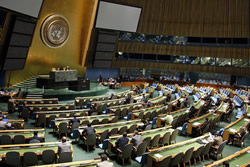 The United Nations was established on 24 October 1945 by 51 countries committed to preserving peace through international cooperation and collective security. Today, nearly every nation in the world belongs to the UN: membership totals 192 countries.
The United Nations was established on 24 October 1945 by 51 countries committed to preserving peace through international cooperation and collective security. Today, nearly every nation in the world belongs to the UN: membership totals 192 countries.
When States become Members of the United Nations, they agree to accept the obligations of the UN Charter, an international treaty that sets out basic principles of international relations. According to the Charter, the UN has four purposes:
- to maintain international peace and security;
- to develop friendly relations among nations;
- to cooperate in solving international problems and in promoting respect for human rights;
- and to be a centre for harmonizing the actions of nations.
###
* The above story is adapted from materials provided by United Nations (UN)
** More information at United Nations (UN)

